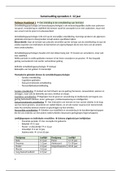Case uitwerking
Module uitwerking werken aan gezondheid
- Vak
- Stage PLP2/3
- Instelling
- Hanzehogeschool Groningen (Hanze)
Voor plp 2 of 3 moet je de module werken aan gezondheid uitwerken. Ik heb dit gedaan tijdens een buitenlandstage waardoor het document engels is. Wel is de module precies hetzelfde als dat het in Nederland zou zijn geweest.
[Meer zien]













